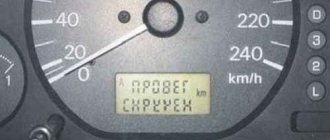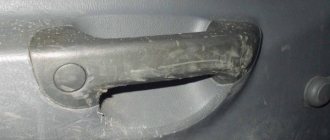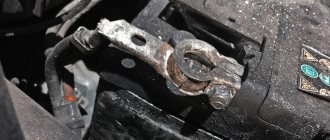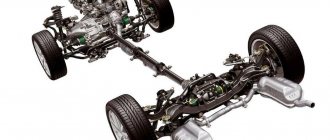Many people know that the quality of domestic road surfaces leaves much to be desired. If in large cities you only have to deal with small potholes and uneven asphalt, then in the outback the problem turns out to be much more serious. To cope with this problem, many manufacturers of both domestic and foreign cars focus on such an indicator as ground clearance. Today we will answer the question of what vehicle clearance is and how it affects the driving performance of the car.
The role of ground clearance in car design
I’ll explain it to beginners! Guys, ground clearance is not some kind of detail, you can’t pick it up, but you can see it!
The domestic GOST explains this concept as the distance between the road and the lowest point of the car and there is nothing to add here, everything is simple and clear!
The value of ground clearance plays a vital role in any car, because its value has a direct impact on such key characteristics of the vehicle as cross-country ability, maneuverability and stability. Therefore, the size of the ground clearance is no less significant a parameter than the same engine size or power.
It would seem that everything is simple, clearance is measured in millimeters, sometimes in centimeters, in principle, it is not so important for those who studied at school. However, the fact that there are many body kit elements in the design of the car can be misleading, where should you measure it? From the crankcase, bumper, exhaust system, transmission or suspension arms? Very soon we will return to this issue and everything will become clear.
Now I would like to draw your attention to the vehicle load factor. After all, you must agree that the number of kilograms taken on board by the “iron horse” determines how much its “knees” (figuratively speaking, of course), in our case the springs, will “bend”, and this, in turn, has a direct impact on the amount of ground clearance.
So the problem is that most automakers on the planet do not have a unified position on this issue, so sellers manage to manipulate the key characteristics of the vehicle.
As for the Russian Federation, we have a certain standard (P50182-92), which states: ground clearance is determined exclusively when the vehicle is fully loaded, not only with passengers, but also with the trunk. In fact, with us, as always, official dealers, when measuring, take into account only 75 kg of weight per driver (where did they see such drivers in Russia) and the weight of a full fuel tank. I won’t even talk about an ordinary car dealership; they won’t take this into account either; they will measure the ground clearance of an empty car and empty the tank.
Ground clearance (ground clearance) of popular foreign cars of recent years
Ground clearance or ground clearance is one of the important characteristics of a car that determines the distance from the road to the lowest point of the central part of the car (for example, a differential, axle, gearbox or engine guard).
When choosing a car, many people look at this parameter and take it into account. This is understandable - for Russian roads and off-road travel, high ground clearance will have a positive effect on cross-country ability. Cars with very low ground clearance will simply not be able to pass in some places. If you like a certain car model, but are not satisfied with its ground clearance, it makes sense to check with car dealerships what varieties of this model are available. Many models of modern imported cars come in different versions. Often for Russia, with our bad roads, many parameters are adjusted, including ground clearance. That is, if for Europe the clearance value is one, then for the Russian version of the car this value may be completely different. Also pay attention to the presence of engine protection. If there is one, check whether the ground clearance has been specified taking this fact into account. If there is no protection, then think about whether you will install it (in most cases, yes). When installing protection, the ground clearance may decrease by approximately 5-15 mm. There is also the concept of “PPD - bad roads package”; manufacturers of imported cars either include it in a certain model or not. The amount of ground clearance also depends on this.
How and why to measure ground clearance
In such a situation, when buying a car, we can only demand that at least the conditions for the clearance measurement procedure be met. Experts recommend performing such actions exclusively on the inspection hole; how the measurements are taken is not so important, whether an ordinary tape measure or a centimeter will do. They also focus on the following nuances:
- Tire pressure must comply with the vehicle's owner's manual.
- A tire installed on a car must comply with the manufacturer’s recommended requirements both in size and profile.
- It is also necessary to load the car at least to a minimum; for this, ballast weighing 75 kg is installed on the front seat, and the weight of a full tank of fuel (40-70 kg) is installed in the trunk.
I think we’ve sorted out the preparatory process, now let’s return to the question of where to measure? The most common areas, which in each individual car can be the lowest point of the entire structure, can be counted about four. It is from them that the clearance value is calculated.
- The bottom point of the pallet, if you have protection installed, the thickness of its sheet must be taken into account when measuring.
- From the base of the bumper and in places where there are plastic overhangs.
- From the muffler resonator and the lower edge of the fuel tank.
- From the lower mounting brackets under the front shock absorber struts.
Well, again, each vehicle has its own low point. For example, on ordinary sedans this is the exhaust system, fuel tank or catalyst. For SUVs - a transfer case or differential, etc.
Types of clearance
Due to the fact that each car has a different ground clearance, we will divide it into three categories:
- Small – passenger cars.
- Medium – SUVs and crossovers.
- The big one is SUVs.
If you haven't yet understood why this is so, now you will. Since there is no single established point for measuring ground clearance, I will show you the difference in readings between these three options based on the most popular lowest elements of the car, the front bumper and the sump housing.
The ground clearance for the above types of cars looks like this:
- Passenger cars - 14-20 cm from the bumper and 12-17 cm from the pan.
- Crossovers and SUVs – 18-25 cm, 17-21 cm.
- SUVs – 20-35 cm, from 20 cm and above.
The highest clearance value is found in specialized equipment. For example, for a conventional row-crop tractor this figure can reach up to 50-70 cm, and in the case of construction equipment, up to 200 cm.
Be that as it may, ground clearance has been and remains an individual characteristic of each vehicle. And although many experts worked to classify cars on this basis, they were not able to do this completely. Therefore, all these three groups should be taken somewhat conditionally, because there are often cases when the ground clearance of an ordinary passenger car is several times higher than the value of a crossover or the same SUV.
Vehicle ground clearance for rough terrain
The SUV looks presentable and looks like an SUV. But the ground clearance of such a car is noticeably lower than that of an SUV, since it is designed for travel on flat road surfaces. If you are going to go to the country on the weekend or constantly travel on a bumpy road with holes and cracks, a low ground clearance will not work. In this case, it is desirable that the ground clearance be at least 1500 millimeters.
Fans of high speeds often reduce the ground clearance to make the car more maneuverable. You don't need an SUV to travel on smooth highways. Low ground clearance allows you to give the car the appearance of a racing car.
From high to low clearance
If you are really thinking about purchasing a new car and are trying to find the best option in terms of not only price, but also ground clearance, I recommend taking a look at the tables I provided! With their help, you won’t have to crawl under a car with a tape measure in your hands at a car dealership; you’ll find out everything here and now. First, look at the height of cars under the class b category.
As you can see, the Mini-Cooper turned out to be small not only in words, but also in deeds - 120 mm. Renault Logan and Daewoo Nexia, popular in our area, have ground clearance of 155 and 158 mm, respectively. Well, the leader was the Ford Fusion with its 175 mm.
What's good about high ground clearance?
High ground clearance has always been valued by true car enthusiasts; its high value definitely increases the status of the car, both visually and functionally. You don’t need to go far here, take for example any Lada car and double its ground clearance. I’m sure the car will appear before you in a completely different form, like an SUV. And you, as a driver, will receive a lot of advantages:
- The visibility around the car will increase significantly;
- Getting into the car will become much easier and more convenient;
- The cross-country ability will also please you; the likelihood of “sitting on your belly” in snow or mud will be significantly reduced;
- The front and rear overhang angles will also increase accordingly, which will keep bumpers and body kit elements from colliding with the road surface or curb.
- Increasing the pitch and roll angle will give you some advantage when overcoming road obstacles.
However, there is one significant drawback to high ground clearance; as it increases, the likelihood of the car overturning increases significantly. So, with faulty shock absorbers and too “soft” springs, excessive swaying of the vehicle will be felt already at a speed of 50-60 km/h. Therefore, the cruising speed for cars with such ground clearance is about 100 km/h.
Of course, cars with low ground clearance have lower fuel consumption, they hold the road perfectly, but when encountering even the smallest obstacle, difficulties may arise in overcoming it; I won’t say anything about off-roading at all. Be that as it may, the relevance of the procedure for independently increasing the clearance value has always been at its best, because even the most “worn car” is transformed before our eyes. If you don't mind increasing the off-road effect, on this page you will learn how to increase the disc offset using special spacers. That's all for me, I hope I was helpful. All the best!
High ground clearance car, pros and cons
Cars with high ground clearance have only one advantage, but a very significant one - cross-country ability, especially considering the quality of the roads in our country. As for the shortcomings, there are some here too. Increased clearance raises the vehicle's center of mass, making it prone to rollover during sharp turns. Therefore, when driving at high speeds on good roads, the ground clearance must be reduced.
Why is clearance needed and what does it affect?
Clearance is explained by GOST as the distance between such parts of the car as the supporting surface and the lowest point of the central part of the entire structure. Simply put, this is the distance that separates the prospect of damaging the lowest part of the car and the road surface. More often, this concept can be heard in such a form as ground clearance - it is more understandable, easier to remember and therefore used with great pleasure.
The amount of ground clearance is a very important characteristic for any car, as it significantly affects stability at high speed, cross-country ability, and maneuverability. And these, without a doubt, are the indicators that can demonstrate the car in the best light. As for cross-country ability, it can be increased along with an increase in value. By the way, this can be done while driving – on some cars.
As a rule, ground clearance is indicated in millimeters, sometimes also in centimeters. It is also common practice to notify car owners about two values - clearance under the front and rear axles. Sometimes they even indicate the clearance that is under the engine crankcase.
How to increase
Increasing ground clearance is quite simple - there are several main ways.
Larger wheels
Changing the ground clearance using larger wheels. This is the simplest and most inexpensive way to increase the clearance height. To do this, the car needs to be “changed” from standard tires to tires with a larger radius or profile. In this case, you need to take into account that choosing wheels of a larger radius when buying a new car, the list of options of which includes wheels of different sizes, will not increase the ground clearance. Stock wheels with a larger radius usually have a lower rubber profile. For example, by changing 195/65R15 wheels to 205/55R16 tires, it will not be possible to increase the ride height, since the outer radius of the wheel remains unchanged. As a result, the clearance indicators are the same. Therefore, in this case, to increase the clearance it is necessary either to increase the profile height or the radius of the wheels. For example, changing tires with 205/55/R15 ratings to 205/55/R16 or 205/65/R15 tires. When replacing tires, you need to take into account that even such a slight intervention in the car’s design can affect the accuracy of the speedometer, and in some cases, damage the speed sensor.
Replacing shock absorbers and springs
Another way to increase the ride height is to replace the shock absorbers and springs with new ones, which make the car sit higher above the road surface. Also, additional inserts and rubber gaskets are installed under the springs, which also affects the ground clearance. Replacement is usually carried out in a specialized car tuning center, but there are many craftsmen who do it themselves.
In this case, two important factors need to be taken into account: the immediate loss of the factory warranty due to interference with the design of the car. As well as an increase in the center of gravity and a concomitant decrease in vehicle controllability at high speeds and in corners. And this directly affects the safety of driving a tuned car.
Suspension upgrade
The third method involves a deep modernization of the suspension. All or most of its structural elements are replaced with new ones, thereby achieving greater vehicle clearance. An excellent way is to install air suspension - in this case, the driver can forever forget about problems with ground clearance, increasing or decreasing it as needed. However, it must be taken into account that such deep tuning is the most expensive way to increase clearance.
High ground clearance is not always a necessary characteristic for a car. If the car owner mostly drives around the city and on highways, then there is simply no need for high ground clearance. In addition, increased ground clearance affects handling and safety. Therefore, there is no point in increasing the vehicle's ground clearance if this is not due to its operating conditions.
Comparative table of car clearance
A comparative analysis of the ground clearance of various cars allows us to enclose all these values in a table, which is given in this material. The table will show the lowest and highest ground clearance values of all three groups of cars given earlier.
The list of SUVs characterized by the highest value should undoubtedly include the following: Land Rover Defender (25 cm under the front bumper, 43 cm under the fuel tank), UAZ Hunter (20.5/40 cm), Nissan Patrol Y62 ( 28.5/30.5 cm), Mercedes-Benz GL500 (28.5/29.7 cm), Volkswagen Touareg (26.5/30 cm).
As for SUVs and crossovers, the table can be explained by two criteria: cars with ground clearance less than 18 cm and more than the same value.
The first group includes the following models: Infiniti EX (14.7 cm), Honda CR-V and Nissan Juke (17 cm), Kia Sportage (17.2 cm), Lifan X60 (17.9 cm), Skoda Yeti and SsangYong Actyon (18 cm).
Second group: Hyundai Santa Fe and Kia Sorento (18.5 cm), Chery Tiggo and Suzuki SX4 (19 cm), Mitsubishi ASX (19.5 cm), Toyota RAV4 (19.7 cm), Suzuki Grand Vitara, Volkswagen Tiguan and Nissan Qashqai (20 cm), Renault Koleos (20.6 cm), Mazda CX-5, Nissan X-Trail and Renault Duster (21 cm), Range Rover Evoque (21.2 cm), Subaru Forester and Mitsubishi Outlander ( 21.5 cm), Subaru XV and Land Rover Freelander (22 cm).
The group of average passenger cars, the indicator of which is within 14-20 cm, includes the following: Chevrolet Cruze and Daewoo Matiz (15 cm), Kia Spectra (15.5 cm), Lada Kalina (15.8 cm), Chevrolet Lanos and Hyundai Solaris (16 cm), Volga GAZ-24 (17.4 cm), Hyundai ix35 (17.5 cm), VAZ-2110 (18 cm), Renault Sandero Stepway (19.5 cm).
A separate category of “passenger cars” whose ground clearance exceeds 20 cm includes: Renault Duster and SsangYong Kyron (21 cm), Ford Explorer (21.1 cm), Toyota Land Cruiser 200 (22.5 cm), and UAZ breaks all records -469 with a value of 30 cm.
Speaking about the highest ground clearance values, it should be noted such a serial vehicle as a row crop tractor. Their clearance can reach 50-70 cm, and for special ones even 200 cm.
This comparative analysis showed that ground clearance is an individual indicator for each car. Despite the fact that, depending on the purpose of the car, its dimensions and other features, ground clearance can be combined into three groups, this distribution is still conditional. Primarily due to the fact that, depending on the model, ground clearance, for example, in passenger cars can reach values even higher than in crossovers. Therefore, before buying another new car, car enthusiasts are advised to check the clearance values - this is in their own interests.
A look into the future
Until recently, it was believed that ground clearance was a constant value set by the manufacturer. There are only a few ways to influence this indicator in any way. To reduce the indicator, shortened springs are installed in the rear and thereby achieve better dynamics. To increase cross-country ability, special spacers of a certain size are used.
However, science does not stand on the dream, and the manufacturer now offers a number of models using a ride height sensor and a hydraulic drive system. This allows you to dynamically change the ground clearance, depending on the quality of the road surface and the need to change the relationship between dynamics and cross-country ability.
The ride height sensor, depending on the operating mode, can change the parameters of the hydraulic drive system in both manual and automatic modes. In the first case, the system responds to controls in the cabin and, depending on the button pressed, increases or decreases the clearance.
In automatic mode, the ride height sensor independently adjusts the ride height, depending on the selected mode. Thus, in the urban cycle, the minimum ground clearance will give the driver the opportunity to save on fuel and achieve good dynamics. In off-road driving mode, high ground clearance will give the car controllability and maneuverability, which are necessary when driving on bad roads.











